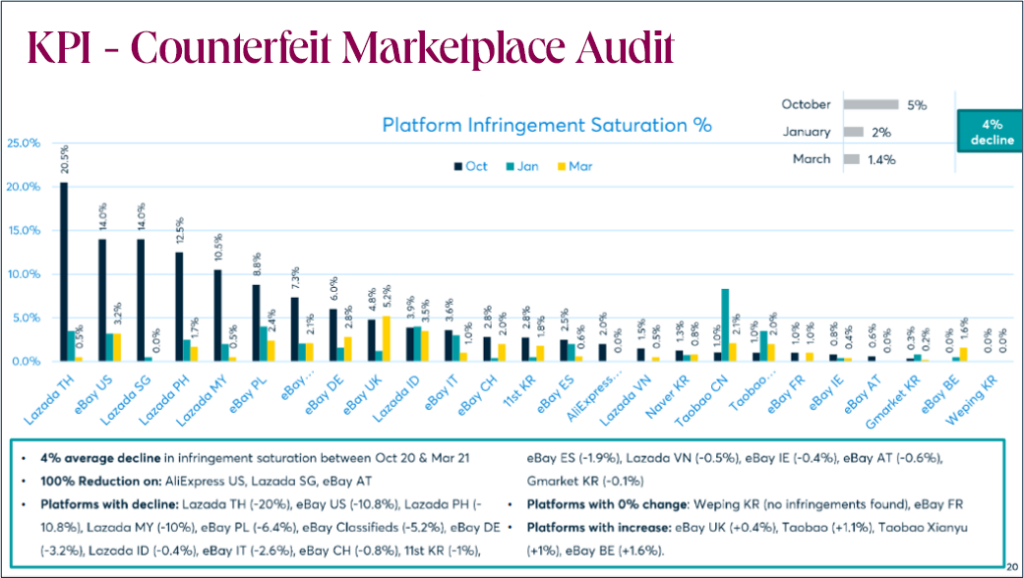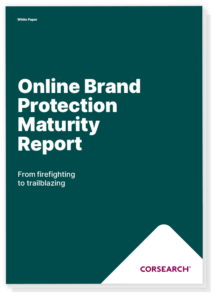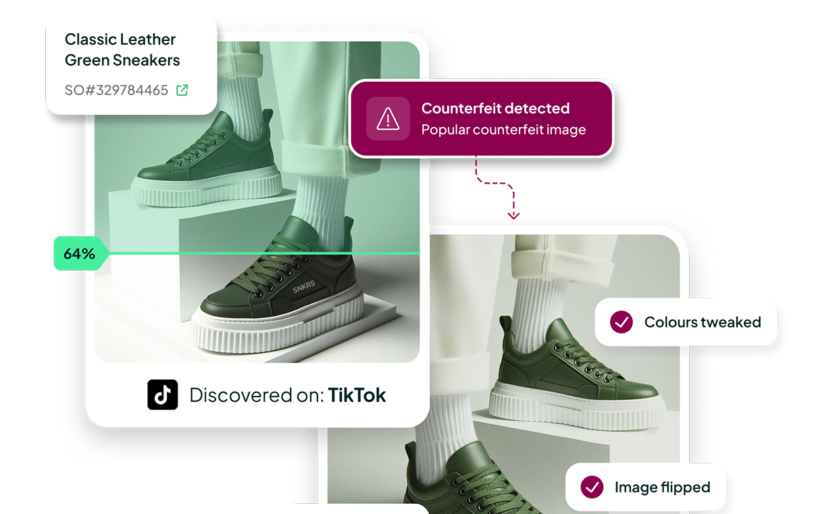Blog
Brand Protection KPIs: How to Focus on Outcomes, Not Takedowns
- Brand Protection

Focus on outcomes, not number of takedowns, to enable your team to deliver commercial value, generate increased ROI, and secure more budget.
With a takedown approach, you are likely not reaping the full rewards of your brand protection program. It can incentivize focusing on the low-hanging fruit – the ‘easy’ enforcement actions that you know will result in a listing removal but may not lead to any lasting impact in terms of the volume of infringement.
However, by transitioning to an outcome approach and refocusing brand protection KPIs you can measure and deliver impact, evolving your team from a cost center to a value generator.
Read this blog to learn:
- The limitations of a takedown approach
- The benefits of an outcome approach
- How to develop an outcome approach
- How a leading brand has successfully engaged in an outcome approach
The limitations of a takedown approach
Many businesses focus on the number of takedowns, with threat prioritization and commercial impact left very much as afterthoughts. Teams may action a large quantity of enforcement notices on a regular basis, but this is an isolated approach with no real visibility of whether issues are under control.
This can stem from the belief that the value of removing a listing on a marketplace situated outside of a core market is equal to a takedown on a priority platform such as Amazon or Alibaba. Teams can also get pulled into the trap of focusing enforcement on platforms with high compliance rates, regardless of how critical they are to their e-commerce strategy.
By focusing solely on takedown numbers, it is difficult to highlight the value of brand protection to both the wider business and to key stakeholders that hold the keys to securing greater budget.
The benefits of an outcome approach
Brand protection leaders have begun to recognize the value of following an outcome approach. Reducing the volume of infringement and protecting consumers on key channels is now becoming one of the key goals of brand protection programs. This ensures teams can deliver commercial value to the business and vastly increase return on investment.
By pivoting team members away from the task of sending reactive enforcement notices, you can free up resources for both targeted enforcement against high-risk infringements and conducting in-depth data analysis.
A reduction in counterfeit sales will follow, leading to increased sales conversion and more effective marketing spend. These are tangible outcomes that you can present to your e-commerce and marketing functions to highlight the value of your team’s efforts.
How to develop an outcome approach
At a basic level, moving from a takedown approach to an outcome approach is about affecting a change in strategy and goals. New brand protection KPIs will need to be set and an emphasis placed on reducing the level of infringement and cleaning up priority platforms.
You’ll also need to make use of more advanced technology such as image capabilities, automated threat prioritization, and data clustering to focus on the greatest threats to your business.
Reporting success
Notices sent and platform compliance are still useful metrics, but you’ll want to demonstrate the impact of your brand protection program on the scale of the problem.
There are a number of key outcomes that you can monitor to gauge the effectiveness of your brand protection program. Examples include:
- Reducing the levels of infringement on a priority platform. I.e. versus the previous month or the last six months
- Reducing the number of issues on each of your key channels.
- Reducing infringement saturation – I.e. for a given search term on marketplaces (& can be applied to organic search), how many listings returned are illegitimate vs legitimate.
- The impact on online revenue
Brand story – leading technology manufacturer
Prior to working with Corsearch, brand X engaged in a takedown approach and focused on hitting an enforcement target each month. While the brand was able to maintain infringement at a steady level, it was unable to reduce it across its priority platforms.
Before – The takedown approach
The primary KPI for brand X was to consistently deliver 3-5k enforcements per month.
However, at Corsearch we know that if enforcements remain at the same level over a long period, then you are unlikely to be significantly reducing infringement. You would expect the number of enforcement notices to drop over time as you tackle repeat offenders and discourage bad actors from listing products on your priority platforms.
Brand X’s brand protection team noted that the rest of their business had been educated to focus on the number of takedowns, but they struggled to see the value of this. The brand protection team itself was unsure if high volumes of enforcement notices were having an impact on the issue.
After – The outcome approach
After partnering with Corsearch, brand X shifted to an outcome approach. Instead of focusing on hitting numerical enforcement targets, the primary KPI instead switched to reducing infringement saturation on key platforms.
The combination of Corsearch’s technology and expertise delivered the following results:
- 80% decrease in enforceable listings between Oct 2020 and Mar 2021
- 74% reduction in counterfeits on key platforms inside 3 months
- 100% reduction in counterfeit saturation on AliExpresss US, Lazada SG, eBay AT
- 77% reduction in counterfeit saturation on eBay US
- Reduction in listings undercutting RRP – competitors saw an increase over the same period

Infringement saturation data for brand X between Oct 2020 and Mar 2021
Two competing brands suffered a 200-400% growth in high-risk data collected between January and March 2021, suggesting their current enforcement approaches are ineffective. However, high-risk data collection for brand X remained consistent throughout this period.
Summary
It’s not about the threats you take down, it’s about the threats that are left online. Instead of focusing on the number of enforcement notices, you can instead engage in targeted enforcement against the high-risk threats, reducing their visibility to consumers on priority platforms.
An outcome approach enables your team to deliver commercial value to the business, paving the way to secure increased buy-in from business stakeholders and additional budget for your team.
Choose a brand protection partner that delivers outcomes
Businesses that switch to Corsearch see greater reduction of infringements, quicker return on investment, and superior long-term business impacts. Operating as a partner rather than vendor, Corsearch enables businesses to understand their threats better, act quicker, and make lasting change.
Corsearch’s brand protection technology is fueled by data clustering, optical character recognition (OCR), logo detection, and image similarity matching, empowering businesses to focus on the high-risk threats that their customers are exposed to.
Harnessing Corsearch’s technology, our expert team of multilingual analysts work directly with online platforms to reduce the volume of infringement and clean up priority channels. Teams using Corsearch also have access to advanced analytics tools to leverage their refocused brand protection KPIs and demonstrate value, highlight trends, and support wider business success.
Speak to one of our experts to learn more about the Corsearch approach
Online Brand Protection Maturity Report
The 4 stages to maximizing your brand’s strategic potential
As they mature, brand protection teams become increasingly strategic – able not only to counter threats, but to identify new growth opportunities for the business.
This report outlines the four stages of this journey, helping you recognize where your organization currently sits, the tools you can use to progress, and the value to be achieved by doing so.






